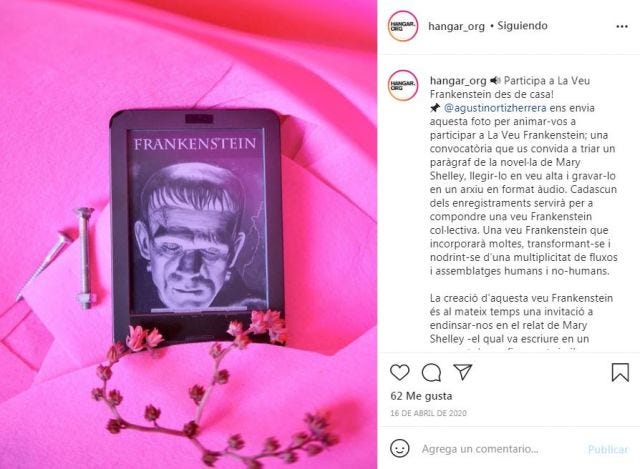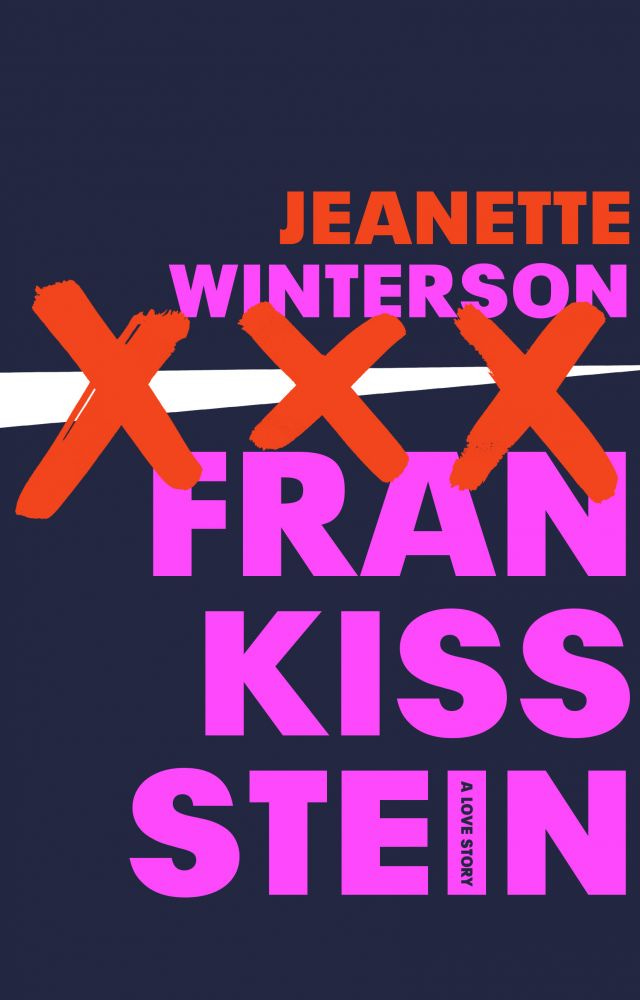Ry Shelley, flores de aciano y bellotas / Ry Shelley, Cornflowers and Acorns
[ English version below, loves ]
Hola, mis líquenes
Hace poco fue el aniversario de la muerte de Mary Shelley— en concreto el día 1 de febrero de 2021 marcó el 175º aniversario de su muerte. Hoy os quiero hablar de ella, y sobre todo de la importancia que ha tenido (¿y tendrá?) Frankenstein en mi vida artística. Esta edición de luto-de-hormigas va a ser un poco diferente. Cuidado, que se vienen saltos temporales, carne viva-muerta y veganismo; no quiero ser la pesada que saca a coalición el veganismo por menos de nada, pero aquí os prometo que viene a cuento. Para quienes me lean hoy por primera vez: ¡Hola! Soy Miriam y normalmente aquí hablo de mi proceso creativo y sobre plantas, y traduzco poesía de otrxs autorxs. Dentro de un par de semanas os llegará un newsletter más estándar.
La voz de la Criatura
En abril de 2020 participé en una convocatoria del Centro Artístico Hangar llamada La voz Frankenstein, parte del programa Ficciones del des-orden. En la convocatoria, Paula Bruna, Carolina Jiménez y Agustín Ortiz Herrera proponían, a todx quien le interesara, enviar a Hangar un audio de una lectura de un fragmento de la novela Frankenstein o el moderno Prometeo en inglés o en castellano.
Afrontar los desafíos y conflictos ecológicos y sociales contemporáneos requiere [...] imaginar nuevas posibilidades de convivencia entre humanos y no-humanos [...]. Sin embargo, el imaginario de lo real está fuertemente constreñido por el pensamiento binario [...]. este programa aspira a traspasar la crítica –sin prescindir de ella– para comenzar a reparar el daño a través de la búsqueda de herramientas poético-políticas que permita un cambio en la producción de la subjetividad [...]. El cuestionamiento de cualquier paradigma de normatividad, [...] del excepcionalismo y el supremacismo que impregna la producción de relatos y la construcción de verdad vinculada al saber. [...] abrazar el desorden en el que estamos inscritxs y que nos conforma.
Para quienes no hayan estudiado filosofía, bellas artes, historia, o alguna de esas humanidades palabreras (os lo dice una verbosa ex-estudiante de bellas artes): Para construir un mundo diferente primero hay que imaginárselo, y para que sea diferente de verdad, hay que pensar fuera de los conceptos binarios a través de los cuales vemos el mundo: naturaleza/cultura, hombre/mujer, máquina/orgánico, vivo/muerto, humano/animal. Me interesan especialmente las teorías filosóficas que se dedican a señalar lo falsedad de estas divisiones binarias, como la teoría queer y la ecología queer. Para cambiar el mundo necesitamos imaginar cómo podríamos hacerlo, y algunos de los vehículos clave para sembrar las semillas de las ideas para ese futuro son la filosofía y el arte. La literatura, el videoarte, el cine, la escultura, la performance, las series de televisión, todos estos y otros medios, ponen sobre la mesa (en nuestras cabecitas) realidades que nos eran ajenas, nuevas posibilidades.
Bellotas y bayas
Flashback al verano de 2018: esta es la edición que me decidí a leer por fin. La saqué de la biblioteca pública y es la edición que me gustaría tener (ejem, mi cumpleaños está cerca). Creo que es de las mejores ediciones en español, porque está dividida en dos partes: el borrador original de la autora (al que le falta el principio y algunos fragmentos del interior), y la versión que posteriormente ella revisó aplicando las notas de Percy B. Shelley (la versión que habitualmente se vende en librerías). De verdad que no es por afán de generar polémica, pero os digo que ojalá hubiera ignorado algunas notas de su marido; la versión final me encanta, pero al comparar con el borrador (cosa que esta edición facilita), se aprecia cómo algunos momentos rayan la pedantería en pasajes que originalmente eran más sintéticos (y puede que más intensos or eso mismo). Así que gracias por eso, Percy, cari.
Aquí se aprecian los dos bloques de esta edición, con cada versión de la novela en un tipo de papel diferente.
Nadie podría nunca imaginar el horror de mi trabajo llevado a cabo en secreto, moviéndome en la húmeda oscuridad de las tumbas o atormentando a un animal vivo al intentar animar la materia inerte. La sala de disección y el matadero me proporcionaban la mayor parte de los materiales.
Curioso ese fragmento de la novela de Frankenstein, ¿no? Si estáis acostumbradxs a cómo se desarrolla el argumento de la mayoría de adaptaciones cinematográficas de esta historia (como yo hasta hace un par de años), os sorprenderá saber que la Criatura fue posiblemente un compuesto de carne humana y carne no-humana. Sorpresa. Leí la novela poco después de que CreArt me informara de que me concedían la Residencia Artística que tendría lugar en el LAVA (Laboratorio de las Artes de Valladolid) en octubre de 2018. Me vi interesada en leer la novela durante la investigación que realicé para el proyecto que les presenté a la convocatoria, cuando vi menciones recurrentes de Frankenstein en este otro libro:
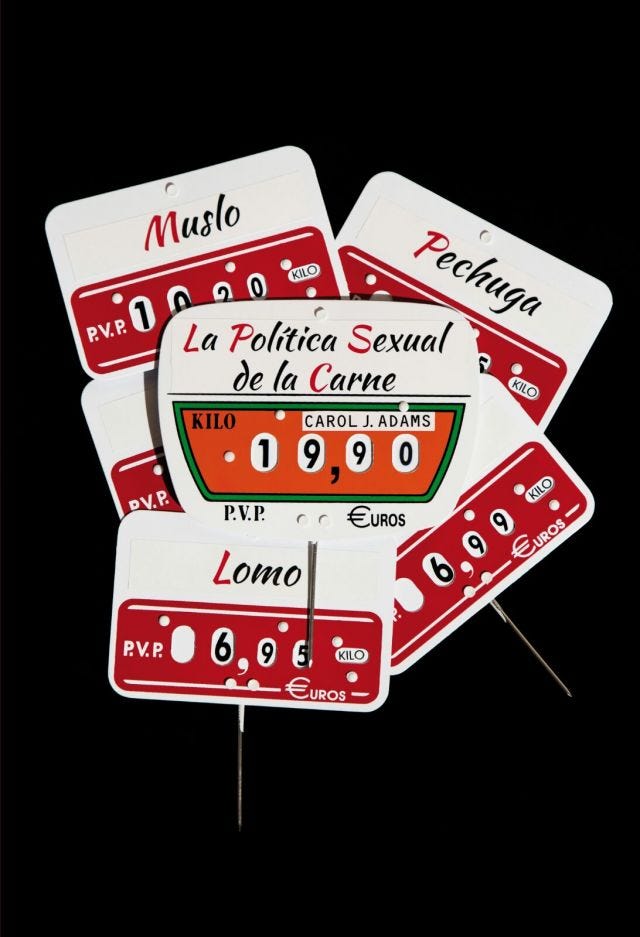
Mi comida no es la del hombre; yo no destruyo al cordero ni al niño para saciar mi apetito; bellotas y bayas me aportan suficiente alimento. Mi compañera será de la misma naturaleza que yo y se satisfará con la misma comida. Haremos nuestra cama con hojas secas; el sol brillará sobre nosotros como sobre el hombre, y madurará nuestros alimentos. La imagen que te presento es pacífica y humana.
Frankenstein, de Mary Shelley
Los mitos de Adán y Eva y Prometeo, claramente evocados en la novela, fueron interpretados en un marco vegetariano durante el periodo Romántico. [...] La Criatura [...] [a]prende que, independientemente de sus propias normas morales inclusivas, el círculo humano está trazado de tal manera que tanto él como los demás animales quedan excluidos. [...] El vegetarianismo de la Criatura anuncia su diferencia y separación de su creador, enfatizando su código moral más inclusivo [le convierte] en un ser más compasivo, que tiene en cuenta cómo explota a otros. Al incluir a los animales en su círculo moral, la Criatura proporciona un símbolo de lo que esperó y necesitó (pero no consiguió recibir) de la sociedad humana.
La política sexual de la carne, de Carol J. Adams
Permitidme que incluya aquí el lema de la Tyrell Corporation, la compañía que en Blade Runner fabricaba a lxs replicantes (básicamente androides, para quien no se acuerde), repetida después por Mariette en Blade Runner 2049:
Más humanos que los humanos.

Una metáfora que ojalá pudiera funcionar
Flash forward: durante el mes de octubre de 2018 desarrollé una performance en base al proyecto que me aceptaron en CreArt. Ese proyecto se convirtió poco a poco en mi performance En cuartas o mitades, una visita guiada ficticia en la que mostré una de las salas del antiguo matadero municipal de Valladolid, reconvertido hace años en el LAVA, Laboratorio de las Artes de la ciudad. Durante la visita me presento ante el público como Luis Ingeniero Industrial, mi alter ego dedicado al oficio que parece, una forma paródica de un hombre relativamente poderoso de los años treinta: voz atronadora, pecho hinchado, condescendiente especialmente con las mujeres. Con este trabajo intenté hacer evidente para quienes me presenciaron el uso original del lugar, donde se conservan parte de las estructuras del matadero y sigue siendo para la población vallisoletana el matadero.

Fotografía tomada por Víctor Hugo Martín Caballero durante la presentación de En cuartas o mitades. Traductora a Lenguaje de signos: Inés Alonso.
Ahora bien, después de explicar siendo Luis cada paso del proceso de sacrificio y preparación, digamos que dejaba de ser ese señor para ser yo; la foto de arriba, por ejemplo, corresponde al momento en el que tras explicar el proceso de despiece del cuerpo de la res, vuelvo a ser Miriam, me dejo caer hasta el suelo y digo:
¿Te acuerdas de aquella tarde? Te dije que iba a salir con mis compañeros de clase. Te pusiste tan triste… Cómo iba a pasármelo bien sin ti… Así que no lo hice. Durante tres años dejé de tener amigos. Dejé de ser una persona y empecé a ser una buena novia. Una tía guay. Una tía muy flexible.
Ante la imposibilidad de mostrar en mi cuerpo el siguiente paso (la división en cuartas o mitades), confieso mis dudas:
El problema con mis anécdotas es que aunque sean verídicas sirven para establecer conexiones empáticas metafóricas. Dejar de ser un sujeto de forma metafórica tiene remedio… Dejar de ser un sujeto literalmente… no. Al final, yo vivo, las reses (cosas), mueren. Y la muerte es demasiado literal.
Esta reflexión se fundamenta en el siguiente planteamiento de Carol J. Adams: “la afirmación [...] ‘carne es asesinato’ dice la verdad literal y hace abandonar el pensamiento simbólico. Parte de la batalla por ser escuchada como vegetariana consiste en ser escuchada sobre cuestiones literales en una sociedad que favorece el pensamiento simbólico.” Entonces camino hasta otra de las columnas metálicas de la sala y extraigo de entre sus huecos una copia de Frankenstein para citar este fragmento:
Nadie podría nunca imaginar el horror de mi trabajo llevado a cabo en secreto, moviéndome en la húmeda oscuridad de las tumbas o atormentando a un animal vivo al intentar animar la materia inerte. La sala de disección y el matadero me proporcionaban la mayor parte de los materiales.
Frankenstein, Mary Shelley
Aunque Victor Frankenstein fuera capaz de revivir la materia muerta (del cementerio y del matadero), yo no puedo traer de vuelta a la vida a los seres que murieron en el espacio en el que hablo.
Asistid al gran fracaso de la metáfora: Las metáforas no salvan vidas. Y tampoco reviven la carne muerta.
Durante esos lapsos en los que era yo, establecía conexiones metafóricas entre los cuerpos que murieron en ese lugar y mi propio cuerpo específico. Pero esa conexión deja de sostenerse en el momento que mi cuerpo sigue entero y vivo: Al final el poder de la palabra es limitado.
Podéis leer más sobre En cuartas o mitades en mi página web, y ver un vídeo (grabado con mucho cuidado y atención al detalle por Rebeca G. Bahíllo) con fragmentos de la performance en mi canal de youtube.
Menos mal que la realidad es hidrosoluble
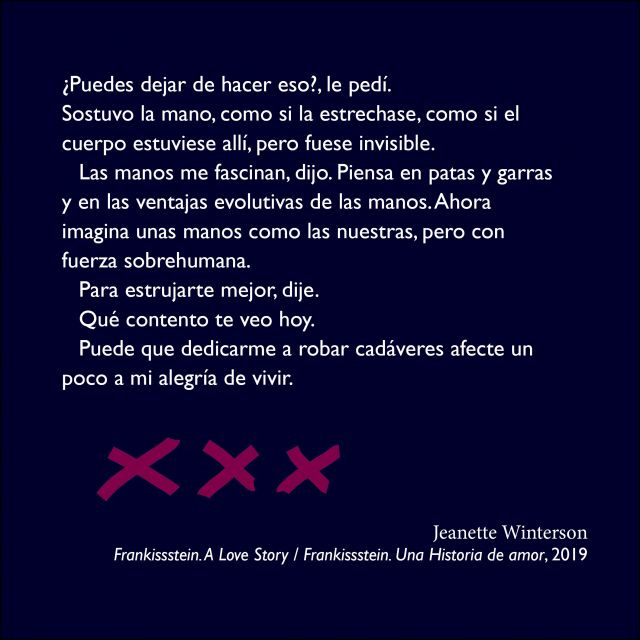
Espero que no os moleste si rescato esta imagen de un newsletter anterior (este: Citas de autoras y tiendita online / Female Writers' Quotes and Tiny Online Shop). Esta novela la conocí gracias a Jen Campbell, una de mis autoras más queridas, que desde que comentó que este era uno de sus libros más esperados de 2019, se convirtió en uno de los míos. Os copio un fragmento de la reseña que hizo para Toast Magazine, donde por cierto, publica reseñas aproximadamente una vez al mes (en inglés):
Jeanette Winterson’s novel Frankissstein opens in 1816. Mary Shelley is roaming the hillside, exploring the world in wonder, much like Frankenstein’s monster — a character she’s yet to write. She’s naked, as if she is the only person on Earth. She notes: ‘My skin is covered in beads of clear water as though I have been embroidered with water.’ And thus begins this fluid novel, where characters and stories bleed into one another, are stitched through the centuries. ‘Reality is water-soluble,’ Mary states.
[ traducción propia ]
La novela de Jeanette Winterson Frankissstein comienza en 1816. Mary Shelley vaga a los pies de una colina, explorando el mundo maravillada, casi como el monstruo de Frankenstein — un personaje al que todavía no ha creado. Apunta: 'Mi piel está cubierta de cuentas de agua clara como si yo misma estuviera tejida de agua.' Y así empieza esta novela fluida, donde los personajes y las historias se filtran entre sí, están tejidos a través de los siglos. 'La realidad es hidrosoluble', dice Mary.
Otra de las líneas narrativas de Frankissstein es la que se desarrolla durante un futuro no demasiado lejano, en el que una especie de Mary Shelley reencarnada en un periodista trans llamado Ry Shelley, conoce al doctor Victor Stein, una especie de reencarnación de Victor Frankenstein obsesionado con la inmortalidad de la conciencia humana a través de su digitalización. Esta es la conclusión de Jen Campbell, que lo cuenta mejor de lo que yo podría:
This ghosting, this repetition, illustrates how humans keep asking the same questions, writing the same stories, falling in love and making the same mistakes, fluidly. The world relies on its beacons to stop everyone crashing against the rocks. Beacons in the form of Mary Shelley and Ry, who have ‘something of a lighthouse keeper in [them]’. Frankissstein, [this daughter] of Frankenstein [...] stretch[s] back in time, and forward again. [It] pause[s] every so often to unearth the stories. To plant new ones. To mutate. [It] read[s] us back to life.
[ traducción propia ]
Esta fantasmagoría, esta repetición, ilustra como lxs humanxs seguimos haciéndonos las mismas preguntas, escribiendo las mismas historias, enamorándonos y cometiendo los mismos errores, de manera fluida. El mundo depende de sus faros para impedir que todxs choquemos contra las rocas. Faros en forma de Mary Shelley y Ry, que tienen 'algo de farerxs'. Frankissstein, [esta hija] de Frankenstein [...] se remonta atrás [o se estira] en el tiempo, y de nuevo hacia adelante. Se [para] cada poco para desenterrar historias. Para plantas otras nuevas. Para mutar. Nos [lee] de vuelta a la vida.
La de cosas que se pueden conseguir por internet
Si tenéis oportunidad, leed cualquiera de los artículos o libros de Jen, por favor. Merece la pena. En español podéis encontrar Cosas raras que se oyen en las librerías y la saga de libros infantiles ilustrados de Franklin y Luna (también recomendable para adultos porque quién hace ascos a las aventuras de un dragón llamado Franklin con una biblioteca a la espalda). Y si sois capaces de leerlos en inglés, sumergíos en su poemario The Girl Aquarium y en su macabra y preciosa colección de relatos cortos The Beginning of the World in the Middle of the Night. Este último arranca con esta cita del Frankenstein de Mary Shelley:
It is true, we shall be monsters, cut off from all the world; but on that account we shall be more attached to one another.
Es verdad que seremos monstruos y que estaremos apartados del mundo, pero precisamente por eso nos sentiremos más unidos el uno con el otro.
Portada del relato corto de Jen Campbell Animals, ilustrada por Aitch. El diseño y el aspecto visual del libro son de Natalie Chen.
Prometo que esta es la última cosa que os cuento relacionada con Frankenstein (por ahora, ha):
These days, you can find anything you need at the click of a button. That is why I bought her heart online. [...] I found Cora ten years ago. We both had articles published in the same journal. Hers was on the history of fairy tales, mine on the poetry of the Romantics. In my essay, I'd touched on the death of Percy Shelley. How, when he was cremated, his friend Edward Trelawny has reached in and pulled his heart out from the flames. His wife, Mary Shelley, took him to court and fought hard to get the heart back. She won and she kept it in her writing desk until the day she died. And people wonder where Frankenstein comes from.
Jen Campbell, Animals (The Beginning of the World in the Middle of the Night)
[ traducción propia ]
Hoy en día, puedes encontrar cualquier cosa con un solo clic. Por eso compré su corazón online. [...] Encontré a Cora hace diez años. Nos publicaron artículos en la misma revista. El suyo era sobre la historia de los cuentos de hadas, el mío sobre la poesía Romántica. En mi ensayo, mencionaba la muerte de Percy Shelley. De cómo, cuando fue incinerado, su amigo Edward Trelawny alargó la mano y sacó su corazón de entre las llamas. Su esposa, Mary Shelley, le llevó a juicio y luchó para recuperar el corazón. Ella ganó y guardó el corazón en su escritorio hasta el día de su muerte. Y la gente se pregunta de dónde sale Frankenstein.
Una vez intenté escribir un poema sobre la Criatura...Fue durante la primera temporada del Círculo de escritura de Neil Hilborn; para Halloween, Neil propuso escribir un poema sobre qué estaba haciendo a día de hoy el monstruo de nuestra elección. No me quedé muy contenta con lo que hice ese día, pero aquí un fragmento:
[...] how could you
ask for a woman, Creature? How
could you never link such a possible body
to the cow's or the bird's you avoided
tearing apart? Even the dead have still
much work to do [...]
[ traducción ]
[...] cómo pudiste
pedir una mujer, Criatura? ¿Cómo
es que nunca conectaste ese posible cuerpo
al de la vaca y le pájaro que evitabas
despiezar? Incluso los muertos tienen mucho
trabajo todavía por hacer [...]
Quién sabe qué acabaré escribiendo al respecto cuando esté más centrada en ello... Pero esto está solo meh, no nos engañemos. Lo que tengo claro es que me interesan muchos de los temas que se plantean en la novela, y las reflexiones que ha hecho al respecto a la filosofía feminista-ecologista-vegana-queer...
Hasta aquí el especial sobre Frankenstein. Lo apreciaría mucho si os apetece comentarme qué os ha parecido esta edición del newsletter. ¿Os gustaría que hiciera este tipo de números especiales de vez en cuando? Podéis escribirme a miriam.navarro.prieto@gmail.com, responder directamente a cualquiera de mis newsletters anteriores que os hayan llegado a vuestro correo, o a través de cualquiera de mis redes sociales (hay una lista con todas ellas en la parte inferior del apartado about me / sobre mí de mi página web).
Los componentes de un té
Para el newsletter anterior (Mariposeo entre pensamientos salvajes / I Butterfly Between Wild Pansies) hice un dibujo de un cuenco de té, y hoy se me ha ocurrido dibujar los ingredientes de uno de mis tés favoritos después de haberlos tenido sumergidos en la tetera. En el dibujo se puede observar una hoja de té verde, una mora seca, y tres flores azules de aciano. Ahora es cuando os dejo un enlace a mi página de kofi por si podéis hacerme una micro-donación. Esta plataforma permite un mecenazgo directo a lxs artistas. Es bastante fantástica porque en su versión más básica no tiene comisiones para lxs creadorxs: todo lo que se dona, va para el/la artista. Aquí el enlace: mi página de kofi. Os agradezco infinito cualquier aportación que os podáis permitir, por pequeña que sea. También os dejo un enlace a mi tienda online, odnde podéis descargar mi poemario y mi fanzine en formato digital, gratis o pagando la cantidad que os parezca adecuada: mi tienda online.
Si es la primera vez que leéis luto-de-hormigas y os ha gustado, podéis suscribiros aquí: luto-de-hormigas / ants-mourning, y aquí podéis leer el archivo con las ediciones anteriores. Al suscribiros, recordad que hay que esperar al mail de Tiny Letter y pinchar en el enlace de confirmación de suscripción. Si ya estabais suscritxs y queréis echarme una mano compartiéndolo en vuestras redes sociales, o recomendándolo en cualquier conversación casual:
- Buenos días. ¿Qué le pongo?
- ¡Hola! Una barra de riche y suscríbase a luto-de-hormigas.
Por cierto, el próximo newsletter será el vigésimo [vítores, aplausos]. Gracias y hasta dentro de un par de semanas,
<3
[ English version starting here ]
Hello, my lichens.
Recently it was Mary Shelley's death anniversary— specifically, 1 February 2021 marks the 175th anniversary of her passing. Today I want to talk about her, and more especifically, about the impact that her Frankenstein had (and will have?) on my artistic life. This edition of ants-mourning is going to be a little different. Beware: we'll have some time-jumps, living-dead flesh, veganism. I don't want to be that annoying vegan who brings the topic anytime, but I promise it does make sense in this context. For the first-time readers: Hi! I'm Miriam and I usually talk in here about my creative process and about plants, and I translate other people's poetry. In a couple of weeks, you'll receive a more standard newsletter.
The Creature's Voice
During April 2020 I took part in an open call by the Barcelona-based Art Centre Hangar named La voz Frankenstein (The Frankenstein Voice), which was part of the program Ficciones del desordenhttps://hangar.org/en/recerca/programes/espanol-ficciones-del-des-orden/ (Fictions of Dis-Order). For the open call, Paula Bruna, Carolina Jiménez y Agustín Ortiz Herrera asked whoever was interested to send Hangar an audio of themselves reading a fragment of Frankenstein or The Modern Prometheus in Spanish or in English.

Afrontar los desafíos y conflictos ecológicos y sociales contemporáneos requiere [...] imaginar nuevas posibilidades de convivencia entre humanos y no-humanos [...]. Sin embargo, el imaginario de lo real está fuertemente constreñido por el pensamiento binario [...] este programa aspira a traspasar la crítica –sin prescindir de ella– para comenzar a reparar el daño a través de la búsqueda de herramientas poético-políticas que permita un cambio en la producción de la subjetividad [...]. El cuestionamiento de cualquier paradigma de normatividad, [...] del excepcionalismo y el supremacismo que impregna la producción de relatos y la construcción de verdad vinculada al saber. [...] abrazar el desorden en el que estamos inscritxs y que nos conforma.
[ personal translation: ]
Facing contemporary ecological and social conflicts challenges and conflicts requires [...] imagining new possibilities of coexistence between human and non-humans [...]. Nonetheless, the imagery of the real is strongly constrained by binary thinking [...]. this program aspires to get through critique -without getting rid of it- to start repairing the damage through the search of poetic-political tools that could enable a change in the production of subjectivity [...]. The questioning of any paradigm of normativity, [...] of the exceptionalism and supremacy that permeates the stories production and truth building tied to knowledge. [...] to embrace the disorder we are inscribed in and that shapes us.
For the ones who haven't studied philosophy, fine art, history, or any of the wordy humanities (this coming from a highly wordy former fine art student): In order to build a different world, first we need to imagine it, and in for it to be truly different, we need to think outside binary concepts we see the world through: nature/culture, man/woman, machine/organic, alive/dead, human/animal. I'm interested in the philosophic theories that make evident the falsehood of these binary divisions, as queer theory and queer ecology. In order to change the world we need to imagine how we could do it, and some of the key ways to plant the seeds of the ideas for tis future are art and philosophy. Literature, videoart, cinema, sculpture, performance art, tv shows, these and other media bring realities to the table (to our tiny heads), realities that were foreign to us, new possibilities.
Acorns and Berries
Flashback to the Summer of 2018: this one is the edition I finally read. I borrowed it from the public library and it's the edition I'd like to have (ehem, my birthday is close). I think this is one of the best Spanish editions, because it's divided in two parts: Mary Shelley's original draft, and the edition usually found in bookstores (the one she wrote applying some of Percy B. Shelley's notes). Believe me, I don't mean to start a fight, but I'm telling you I wish she wouldn't have applied all of her husband's notes; I love the final version, don't get me wrong, but compared to the draft (easily done with this edition), I'd say some moments come close to pedantry. And most of the times those passages were more synthetic and maybe more intense because of that. So thanks a lot, Percy, hon.
Her you can see the two parts, each one printed on a different paper.
Who shall conceive the horrors of my secret toil, as I dabbled among the unhallowed damps of the grave, or tortured the living animal to animate the lifeless clay? [...] The dissecting room and the slaughterhouse furnished many of my materials.
If you're used to how the story goes on most cinema adaptations (as I was until not so long ago), you may be surprised by that fragment. I read the novel after I got the news about CreArt accepting my project for their artists' residence at LAVA (Valladolid's Arts Laboratory) in October 2018. I got interested in reading Frankenstein during my investigation for this project, when I read several references to the novel in this other book:
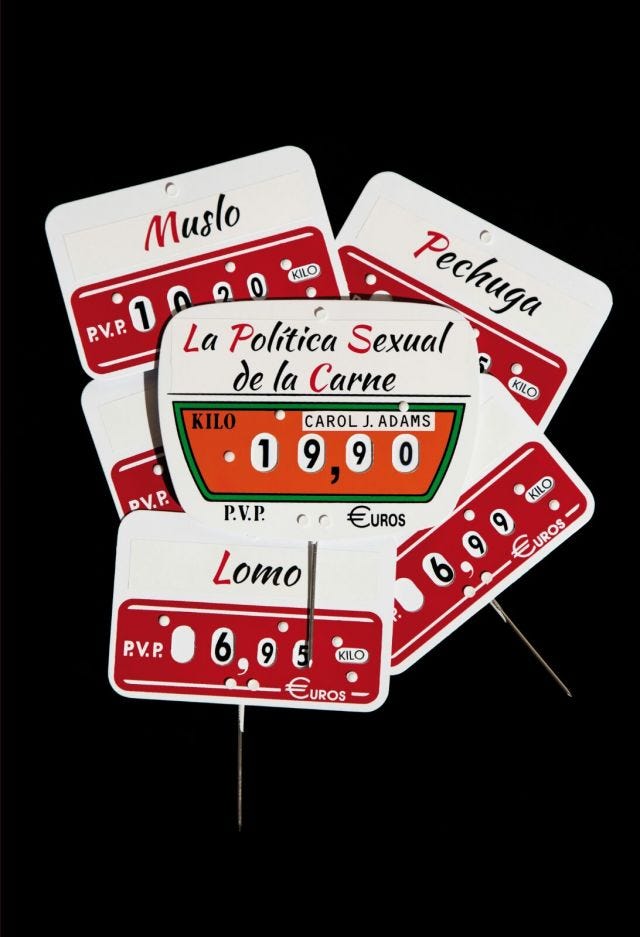
My food is not that of man; I do not destroy the lamb and the kid, to glut my appetite; acorns and berries afford me sufficient nourishment. My companion will be of the same nature as myself, and will be content with the same fare. We shall make our bed of dried leaves; the sun will shine on us as on man, and will ripen our food. The picture I present to you is peaceful and human.
Frankenstein, Mary Shelley
The myths of Adam and Eve and Prometheus, clearly evoked in the novel, were interpreted in a vegetarian framework during the Romantic period [...]
The Creature [...] learns that regardless of its own inclusive moral standards, the human circle is drawn in such a way that both it and the other animals are excluded from it. [...] Vegetarianism is one way that the Creature announces its difference and separation from its creator by emphasizing its more inclusive moral code. The Creature’s vegetarianism serves to make it a more sympathetic being, one who considers how it exploits others. By including animals within its moral circle the Creature provides an emblem for what it hoped for and needed—but failed to receive—from human society.The Sexual Politics of Meat, by Carol J. Adams
Allow to include here Tyrell Corporation's (the company that built the replicants in Blade Runner), later repeated by Mariette in Blade Runner 2049:
More human than human.

A metaphor I wish were real
Flash forward: during the month of October 2018, I developed a performance based on the project CreArt gave me green light for. This project slowly became En cuartas o mitades (In Quarters or In Halves), a fake guided tour through one of Valladolid's old public slaughterhouse, years ago reconverted into the city's LAVA (Arts' Laboratory). During the tour I present myself to the audience as Luis Industrial Engineer, an alter ego that parodies a relatively poweful thirties' man: loud voice, conceited, condescending especially to women. With this piece I tried to make evident the original use of the place we were in, where there are still structures used in the slaughterhouse, and for the general public in Valladolid is still being named the slaughterhouse, at least as a (pretty common) meeting point.
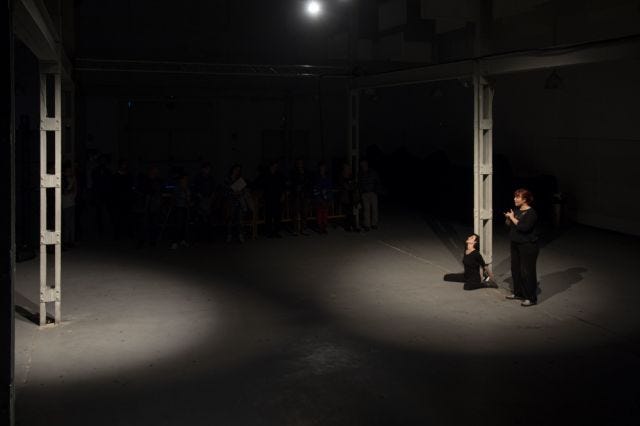
A picture Víctor Hugo Martín Caballero took during the public presentation of In Quarters or In Halves. Sign Language translator: Inés Alonso.
Now, after explaining each part of the sacrifice and preparation as Luis, let's say I stopped being that dude to be myself during brief moments; the picture above, for example, was taken right after I explained the quartering of the cattle's body, when I was Miriam again, let myself fall to the floor and say:
Do you remember that afternoon? I told you I was going out with my classmates. You got so sad... How could I have fun without you? So I didn't. For three years I stopped being as person to be a good girlfriend. A cool girl. A very flexible chick.
Confronted with the impossibility of replicating the next step of the process in my body (the halving and quartering), I confess my doubts:
The problem with my metaphors in that , although they're truthful, they're trying to establish metaphorical empathetic connections... Stopping being an individual in a metaphorical sense has a remedy... Stopping being an individual in a literal sense... doesn't. At the end. I live, the cattle (thing) die. And death is too literal, too irreversible.
This reflection is based upon this one by Carol J. Adam's: Th e statement [...] “meat is murder,” speaks the literal truth and calls one away from symbolic thinking. Part of the battle of being heard as a vegetarian is being heard about literal matters in a society that favors symbolic thinking." Then I walk to another metal pilar in the room and extract a copy of Frankenstein from a cavity inside it to read this fragment:
Who shall conceive the horrors of my secret toil, as I dabbled among the unhallowed damps of the grave, or tortured the living animal to animate the lifeless clay? [...]. The dissecting room and the slaughter-house furnished many of my materials.
Frankenstein, Mary Shelley
Even though Victor Frankenstein was able to revive dead flesh (from the cemetery and the slaughterhouse), I cannot bring the creatures who died here back to life:
Come witness the great failure of metaphor: Metaphors do not save lives. Nor they revive dead flesh.
During these intervals in which I was myself, I established metaphorical connections between the bodies that died in that place, and my own specific body. But that connection stops being possible in the moment I realize my body is still whole and alive: In the end the power of words is limited.
You can read more about In Quarters or In Halves on my website, and watch a video (very carefully recorded by Rebeca G. Bahíllo) of the piece's overview on my youtube channel.
Good thing reality is water-soluble

I hope you don't mind if I reuse this picture from a previous newsletter (this one: Citas de autoras y tiendita online / Female Writers' Quotes and Tiny Online Shop). I knew about this novel thanks to one of my most beloved authors, Jen Campbell, and since she said it was one of her most anticipated 2019 book, it became one of mine too. Here's a fragment from her review on Toast Magazine, where she publishes a new book review monthly:
Jeanette Winterson’s novel Frankissstein opens in 1816. Mary Shelley is roaming the hillside, exploring the world in wonder, much like Frankenstein’s monster — a character she’s yet to write. She’s naked, as if she is the only person on Earth. She notes: ‘My skin is covered in beads of clear water as though I have been embroidered with water.’ And thus begins this fluid novel, where characters and stories bleed into one another, are stitched through the centuries. ‘Reality is water-soluble,’ Mary states.
One of the other narratives in Frankissstein is the one that's set in a not-so-distant future, in which Mary Shelley is kind of reincarnated in a trans masc journalist named Ry Shelley, and meets the doctor Victor Stein, a kind of reincarnation of Victor Frankenstein obsessed with immortality of human consciousness through its digitalization. This is Jen Campbell's conclusion, which is sharper than mine would be:
This ghosting, this repetition, illustrates how humans keep asking the same questions, writing the same stories, falling in love and making the same mistakes, fluidly. The world relies on its beacons to stop everyone crashing against the rocks. Beacons in the form of Mary Shelley and Ry, who have ‘something of a lighthouse keeper in [them]’. Frankissstein, [this daughter] of Frankenstein [...] stretch[s] back in time, and forward again. [It] pause[s] every so often to unearth the stories. To plant new ones. To mutate. [It] read[s] us back to life.
Ah, the stuff you can get online
If you have the opportunity, read any of Jen's articles or books, please; she's brilliant. From Weird Things Customers Say In Bookshops (non-fiction based on her ten-year experience as a bookseller, it has a sequel too), to the Franklin and Luna saga (it's supposed to be for kids, but come on, who doesn't want to know more about a dragon named Franklin and the library he carries on his back). And especially her poem collection The Girl Aquarium and her macabre and captivating short story collection The Beginning of the World in the Middle of the Night. This last one starts off with this Mary Shelley quote:
It is true, we shall be monsters, cut off from all the world; but on that account we shall be more attached to one another.
Cover for Jen Campbell's short story Animals, illustrated by Aitch. The book's design and visual concept are by Natalie Chen.
I promise this is the last thing I share about Frankenstein (for now, ha):
These days, you can find anything you need at the click of a button. That is why I bought her heart online. [...] I found Cora ten years ago. We both had articles published in the same journal. Hers was on the history of fairy tales, mine on the poetry of the Romantics. In my essay, I'd touched on the death of Percy Shelley. How, when he was cremated, his friend Edward Trelawny has reached in and pulled his heart out from the flames. His wife, Mary Shelley, took him to court and fought hard to get the heart back. She won and she kept it in her writing desk until the day she died. And people wonder where Frankenstein comes from.
Jen Campbell, Animals (The Beginning of the World in the Middle of the Night)
Once I started writing a poem about the Creature... It was during the First Season of Neil Hilborn's Writer's Circle; for the Halloween session, Neil proposed to write a poem-update about a monster's life. I'm not happy with it, but here's a fragment:
[...] how could you
ask for a woman, Creature? How
could you never link such a possible body
to the cow's or the bird's you avoided
tearing apart? Even the dead have still
much work to do [...]
Who knows what I'll write about all this when I'm more focused... But this is just meh, let's be honest. What I know is that I'm interested in many of the topics the novel brings up, and in the reflections feminist-ecologist-vegan-queer philosophy is developing about them.
Frankenstein special edition over. I'd very much appreciate it if you could tell me what you think about this edition. Would you like to read more special editionsin the future? You can send me an email to miriam.navarro.prieto@gmail.com, or just answer to any of the newsletters you received from me, or you can contact me through any of my social media platforms (there's a list with all of them at the bottom of my website's about me section).
What a tea is made of
For the previous newsletter (Mariposeo entre pensamientos salvajes / I Butterfly Between Wild Pansies) I drew a tea cup; today I thought I could draw the ingredients of that same blend after having them soaked in the teapot. In the drawing you can see a green tea leaf, a dried berry, and three blue acorn flowers. Now is when I drop a link to my kofi page. This is a micro-donation platform that allows you to help the artists you like. It's pretty awesome, because in this basic version they don't charge any taxes to the artists: everything you donate arrives safely to the artist. Here's the link: my kofi page. I thank you immensely any contribution you can make, however small it may be. It all helps me sustain myself while creating.
If this is the first time you read ants-mourning and you liked the experience, you can subscribe here: luto-de-hormigas / ants-mourning, and you can read the archive with all the previous editions here: newsletter archive. When subscribing, don't forget to click on the confirmation link Tiny Letter will send you. If you were already subscribed and you'd like to help me out, share it on your social media or in any casual conversation:
- Good day! What can I get you?
- Hi! An orange juice and subscribe to ants-mourning.
By the way, next edition will be my twentieth [loud cheering, applause]. Thank you and bye until a couple of weeks,
<3




